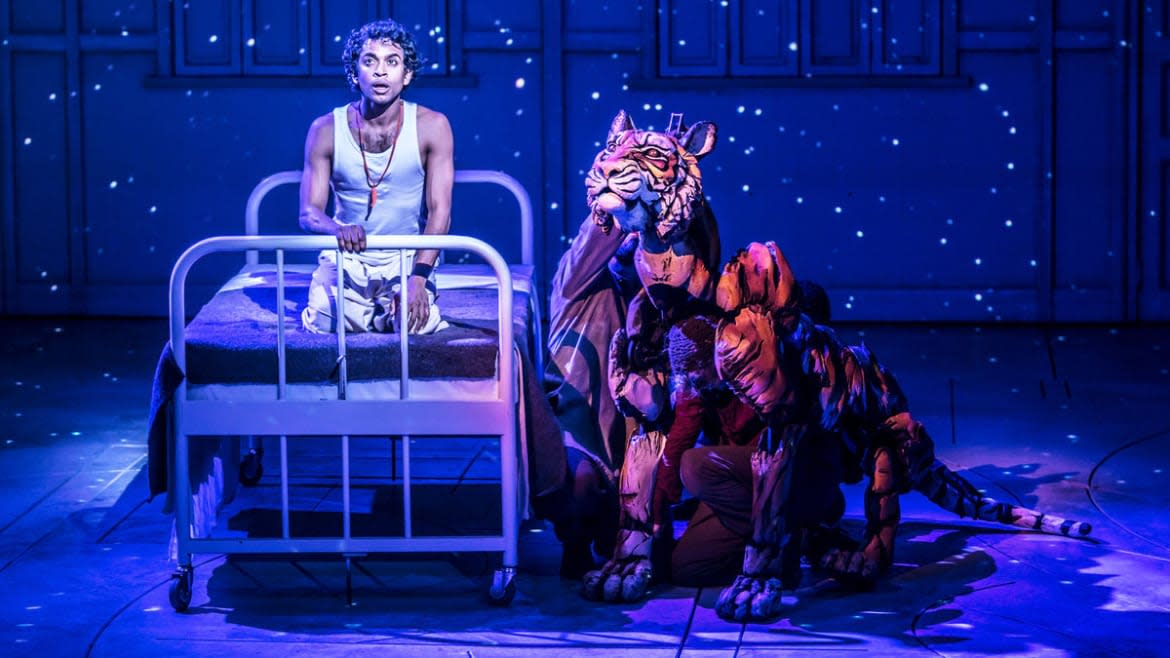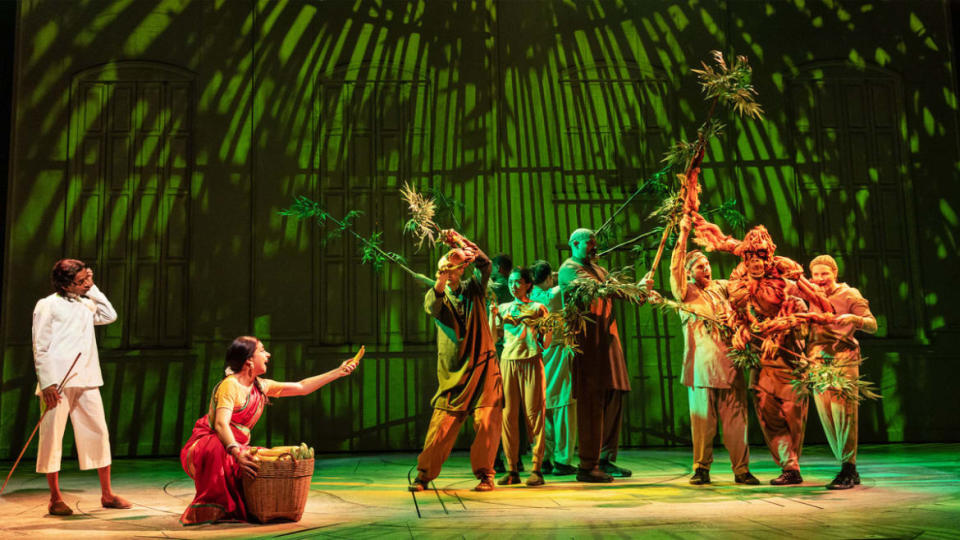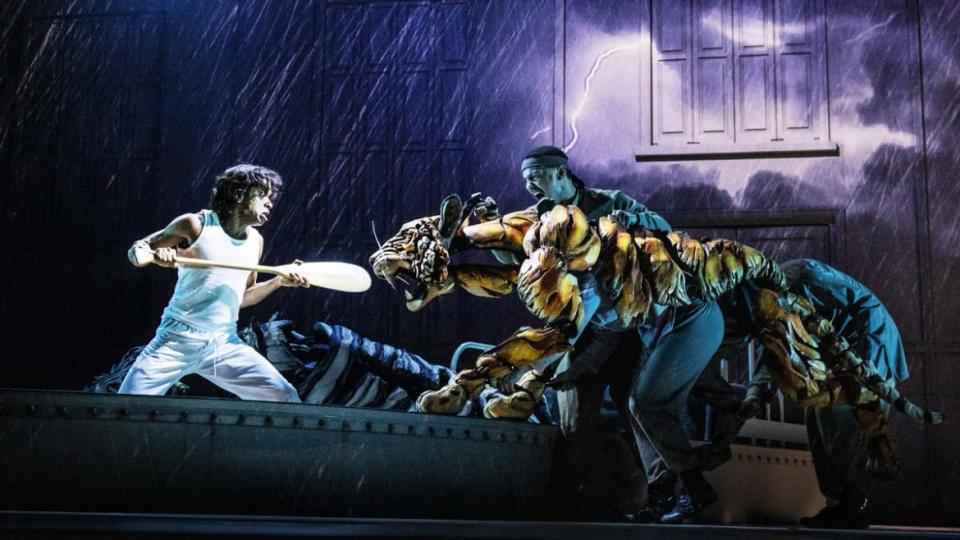‘Life of Pi’ Broadway Review: When You’re Lost at Sea With a Hungry Tiger

Among the five Olivier Awards Life of Pi won in London last year was a best supporting actor award for the seven actors who operate the show’s impressive puppet Royal Bengal tiger, Richard Parker. This creature—who really does become more terrifying as the performance continues—is both the nemesis and intimate of 16-year-old Pi (Hiran Abeysekera), first freaking him out at his family’s zoo in India, and then supposedly on board a rescue vessel, the two of them floating for many days on the high seas of the Pacific Ocean, with the tiger only kept from chomping down on our hero by the placating effects of an orange whistle.
Two of the seven award-winning operators—Fred Davis and Scarlet Wilderink—have crossed the Atlantic to help operate Richard Parker for Life of Pi’s Broadway production (Gerald Schoenfeld Theatre, to Sept 3). Parker is a vibrantly colored and modeled puppet, whose languidly threatening gait is a feat not just of model-making but also the physical skills of his operators. His roar is pretty damn real too. At one point he even acquires a voice, channeled by Brian Thomas Abraham, who doubles as the ship’s scary chef.
‘Sweeney Todd’ Review: Josh Groban and Annaleigh Ashford Shine in Broadway Revival
The danger of Richard Parker has been established early in Life of Pi, a charming theatrical adaptation by Lolita Chakrabarti of Yann Martel’s bestselling novel that for all its puppetry and special effects feels a gentle, modest enterprise. We first meet Pi in the hospital bed he wakes up in in Mexico after his dramatic adventure, to many questions from an official. The sudden sight of a looming giraffe’s neck in this all-white room is the first sign to expect a clash of magic and realism, as the explanation of what happened to him unfolds.
On cue, we go back in time to the family zoo, and Pi’s gruff dad (Rajesh Bose), mom Amma (Mahira Kakkar, who also plays Orange Juice, the orangutan), and joshing sister Rani (Sonya Venugopal). We see the younger Pi play with a cute goat called Buckingham—he certainly has a Doolittle-ish way with animals)—and then the storm clouds of political upheaval descend.

l to r: Hiran Abeysekera, Mahira Kakkar and company in 'Life of Pi.'
His dad doesn’t think Pi understands the gravity of what is befalling India, and by extension the family, and so makes Pi watch Richard Parker attack and eat Buckingham as a kind of violent introduction to the adult world, a deliberate shattering of innocence done not out of cruelty but a wrongheaded worry. Watching the killing is meant to be a lesson in cold, hard reality—and it presages the harsh journey into adulthood Pi will experience when his entire family, save him, dies at sea.
Life of Pi, directed with a restrained sense of wonder by Max Webster, is a very simple story: will Pi and Richard Parker be rescued from the sea; and will Pi’s rescuers believe his story? Is it true? And if it isn’t, does it matter if it is as enchanting as the theater-makers attempt to make it?
The puppets— there is also a zebra and hyena—are designed by Nick Barnes and Finn Caldwell, who also oversees their movement. The show’s striking video design and animation (by Andrzej Goulding) and lighting (by Tim Lutkin) flood the stage with color and movement. Maps charting the ship’s course unfurl in front of us. The rescue vessel (a slick and clever piece of design by Tim Hatley) emerges out of the floor to relate the story of Pi and Richard Parker’s many days at sea.

l to r: Hiran Abeysekera, Richard Parker (Fred Davis, Scarlet Wilderink, Andrew Wilson).
After watching so much colorful storytelling, and wondering if it is merely a figment of Pi’s food and water-starved imagination, Pi offers an alternative, much more prosaic story of what happened to him near the end of the show—a story that includes no fantastical visions of large animals somehow surviving shipwrecks and taking to a rescue boat to alternately torment and then strangely bond with the one human survivor.
Abeysekera’s performance won him the Best Actor Olivier award in London—and it is one of great charm; he is alternately whimsical and in thrall to the magic of animals, yet also dry, funny, and very grounded in the absurdity of the situation around him. He knows how crazy he sounds, he knows how crazy all that he allegedly experienced sounds, and he is confident and self-assured enough to own the truth he feels is real, while also expounding a more down-to-earth alternative when encouraged to. It is a shame we don’t spend more time with his family; their chemistry and inviting characters are cut short too quickly. In their place is a shaggy tiger tale. Whatever is or isn’t true about what happened to Pi, what resonates is an act of colorful imagining—and Richard Parker’s menacing roar.
Get the Daily Beast's biggest scoops and scandals delivered right to your inbox. Sign up now.
Stay informed and gain unlimited access to the Daily Beast's unmatched reporting. Subscribe now.

 Yahoo Movies
Yahoo Movies 
